Extending up from the banks of Lake Geneva, Lausanne is known as the headquarters for the International Olympic Committee and the home of 13th-century Cathedrale du Notre Dame, one of the finest Gothic cathedrals in Europe and the spiritual capital of French-speaking Switzerland. Lausanne also has a vibrant arts and music scene, and many excellent restaurants.
We only had an afternoon to spend in the city, after spending the morning traveling from Lugano, but were able to experience a bit of everything Lausanne has to offer. From our base along with waterfront in the Ouchy neighborhood, we explored the port area, then rode the Metro up to the city’s medieval center. There we toured the spectacular Cathedrale du Notre Dame, with its Giugiaro-designed organ and sweeping city views from the belfry. We returned back down to the waterfront to visit the excellent Olympic Museum, pictured above, then had a delicious dinner back in the medieval center. In the evening we caught a bit of the The Festival de la Cite, a week-long event held annually in Lausanne’s historic district that combines theater performances with music, dance, circus and installations.
Below are highlights from July 7th, 2022. Click any image for a larger view, or click the position to view the location on a map. And a map with our most recent log entries always is available at mvdirona.com/maps.
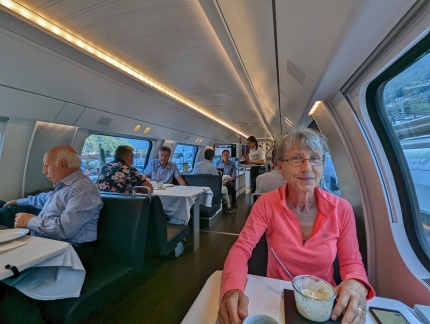 |
Dining Car
Position: 46°11.70’N, 9°1.74’E
Breakfast in the upper level dining car on an early morning train en route from Lugano to Lausanne.
|
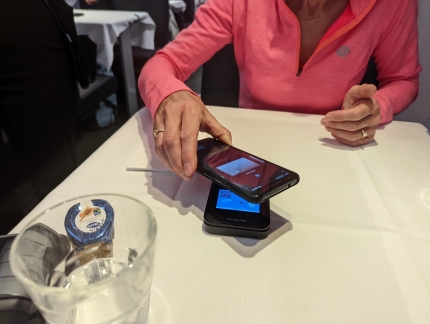 |
PayWave
Position: 46°22.23’N, 8°55.76’E
Using a US credit card in Europe can be a real pain, or not even possible, if a signature is required. But we can instead seamlessly use payWave on our phones with our US credit card.
|
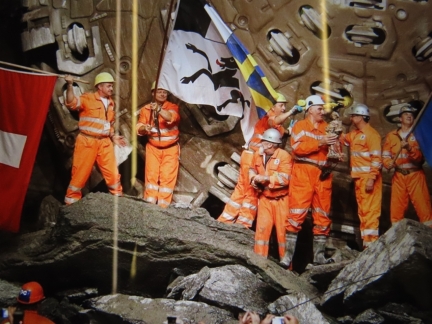 |
Gotthard Base Tunnel
Position: 46°39.88’N, 8°44.71’E
A 2010 picture of workers in front of the giant drill machine ‘Sisi’ celebrating after breaking through the final section of the Gotthard Base Tunnel. Completed in 2016, it is the longest railway and deepest traffic tunnel in the world. We’re currently in the tunnel and are passing underneath our route on the Glacier Express a few days ago.
|
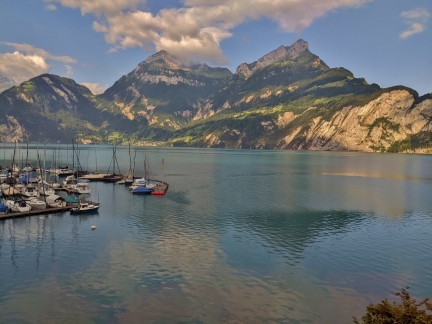 |
Lake Lucerne
Position: 46°56.09’N, 8°37.05’E
A brief glimpse to the eastern shores of Lake Lucerne en route from Lugano to Lausanne.
|
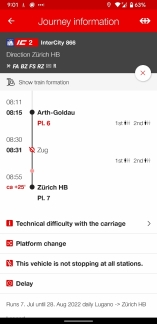 |
Train Delay
Position: 46°0.37’N, 8°56.78’E
The Swiss trains have a reputation for being remarkably on-schedule, and that has been our experience on most of our trip. But today we’re experiencing an unusual delay, where the train is over an half-hour late and is actually going to skip a stop in Zug. We were planning to connect in Arth-Goldau to Lausanne via Lucerne, but it’s faster for us to just keep going to Zurich and connect from there instead.
|
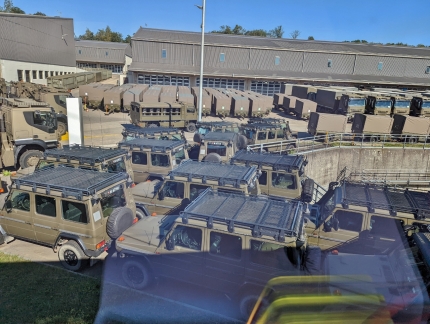 |
Army Logistics Center
Position: 47°24.03’N, 8°12.45’E
The huge Army logistics center in Othmarsingen, full of vehicles and trailers of many sizes, is clearly visible on the satellite imagery.
|
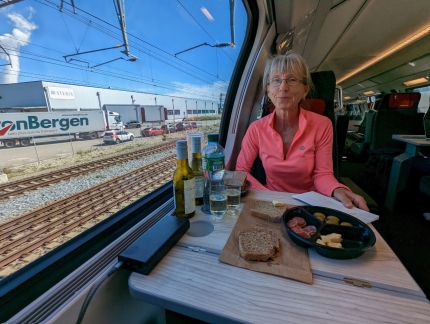 |
Early Lunch
Position: 47°21.32’N, 7°58.34’E
Enjoying an early lunch on the train to Laussanne. The train arrived into Zurich even later than expected and we barely made our connection.
|
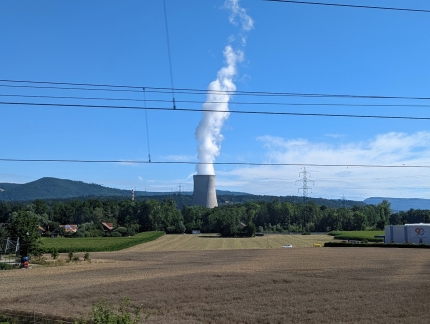 |
Gosgen Nuclear Power Plant
Position: 47°21.10’N, 7°57.69’E
The cooling tower of the Gosgen Nuclear Power Plant in Daniken. Brought online in 1979, the plant has a net electrical power output of 970 MW.
|
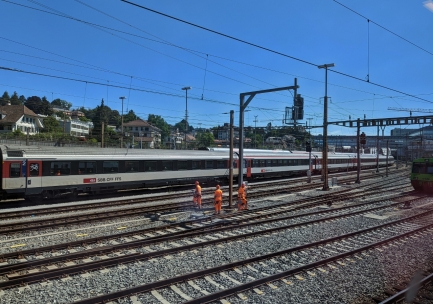 |
Bern
Position: 46°56.99’N, 7°25.93’E
Passing through Bern, the capitol of Switzerland. The city was made the capitol in 1848 to avoid a concentration of power in the larger centers such as Zurich.
|
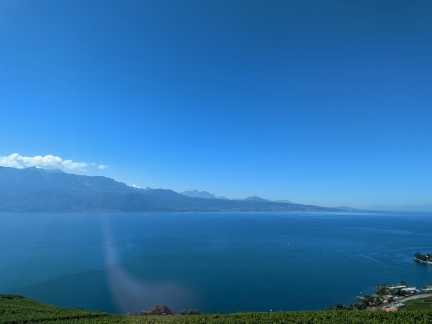 |
Lake Lucerne
Position: 46°29.77’N, 6°44.38’E
Our train exited a tunnel just west of Puidoux and Lake Lucerne burst into view. The Swiss-French border runs through a portion of the lake and the mountains visible are in France.
|
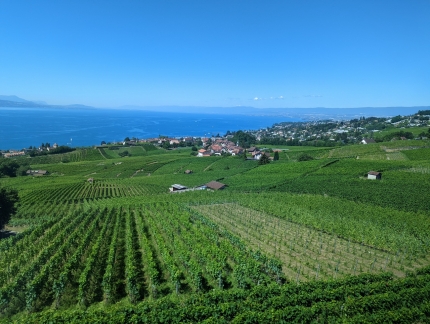 |
Vineyards
Position: 46°29.77’N, 6°44.38’E
Vineyards fill the slopes above Lake Lucerne.
|
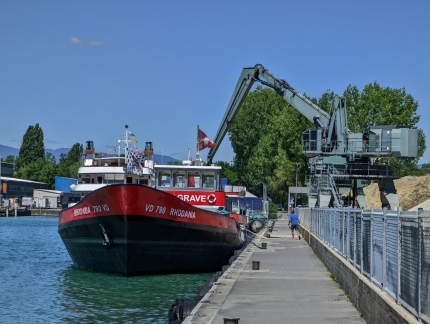 |
Rhodania
Position: 46°30.46’N, 6°37.27’E
After arriving into Lausanne, we dropped off our bags at our hotel and set out for the afternoon. This is the barge Rhodania in the Port Lausanne-Ouchy.
|
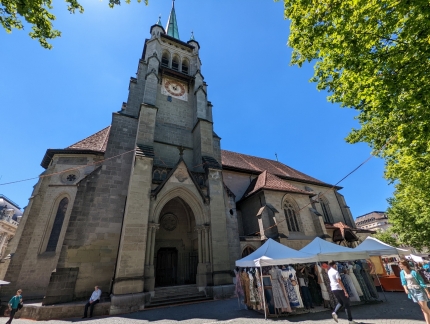 |
Saint-Francois Church
Position: 46°31.20’N, 6°38.00’E
Construction of Saint-Francois Church in Lausanne started in the 14th century.
|
 |
Place du la Palud
Position: 46°31.31’N, 6°38.00’E
Place du la Palud dates to the 9th century as a medieval town square.
|
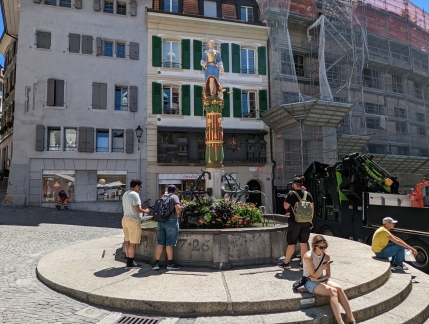 |
Fontaine de la Justice
Position: 46°31.31’N, 6°37.99’E
The Fontaine de la Justice statue in Place du la Palud. This is a 1930 copy of the original, that was erected here in 1585 and now is in the Historical Museum of Lausanne.
|
 |
L’Horlage de la Palude
Position: 46°31.31’N, 6°38.00’E
L’Horlage de la Palude (clock of Palude) is a talking mechanical clock built for the 1964 Swiss national exhibition. Every hour, the clock comes to life with words, music and several parades of figures to tell the history of the area.
|
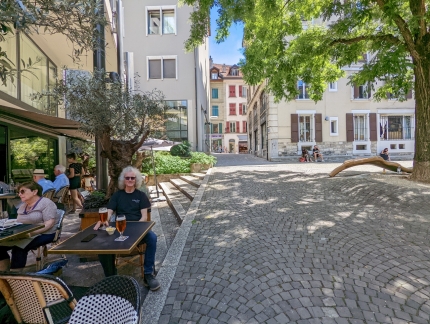 |
Le Comptoir des 3 Places
Position: 46°31.35’N, 6°37.96’E
Enjoying a drink at Le Comptoir Des Trois Places along tree-lined Place de la Riponne.
|
 |
Escaliers du Marche
Position: 46°31.33’N, 6°38.03’E
Taking the historic Escaliers du Marche from Place de la Palud to historic district and the Cathedrale du Notre Dame, visible at top. A staircase has been in existence here since at least the 13th century and the current stairway was completed in 1719.
|
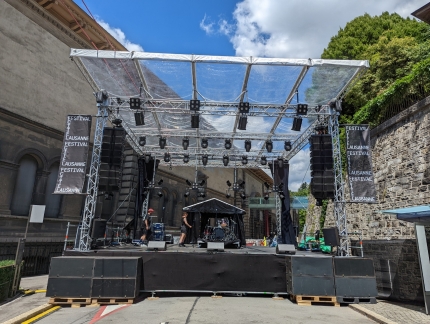 |
Festival de la Cite
Position: 46°31.37’N, 6°38.04’E
The Festival de la Cite is held annually in Lausanne’s historic district. The week-long event combines theater performances with music, dance, circus and installations. Crews and performers were preparing the stage and getting ready for an evening music concert along blocked-off Rue Pierre-Viret.
|
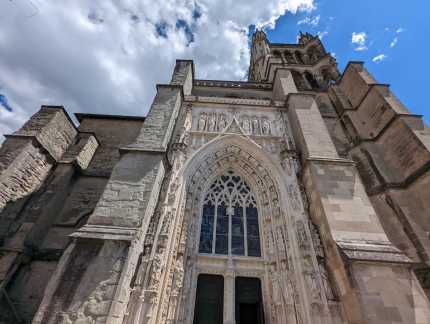 |
Cathedrale du Notre Dame
Position: 46°31.36’N, 6°38.06’E
The ornately carved exterior of Lausanne’s Cathedrale du Notre Dame, constructed during the 12th and 13th centuries. It is one of the finest Gothic cathedrals in Europe and the spiritual capital of French-speaking Switzerland.
|
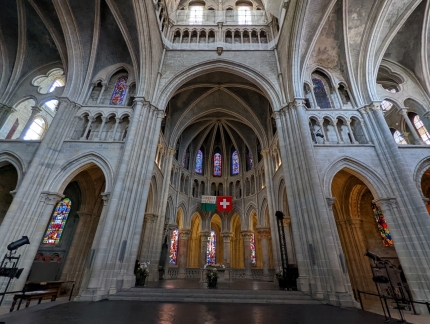 |
Chancel
Position: 46°31.37’N, 6°38.13’E
Looking past soaring ceilings to the chancel of the Cathedrale du Notre Dame.
|
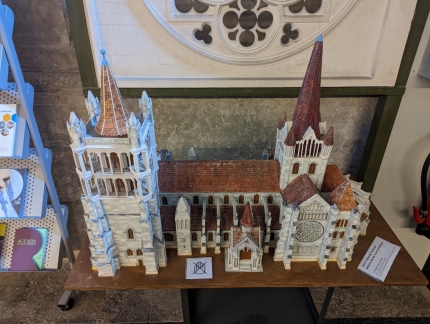 |
Model
Position: 46°31.35’N, 6°38.10’E
A wonderful model of the Cathedrale du Notre Dame inside the cathedral.
|
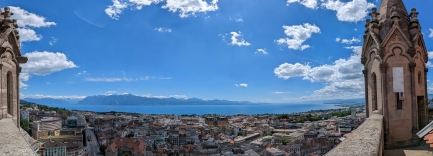 |
Belltower View
Position: 46°31.36’N, 6°38.10’E
The sweeping view across Lausanne to Lake Geneva from the balcony high up on the belfry of the Cathedrale du Notre Dame.
|
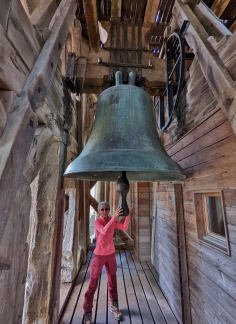 |
Bell
Position: 46°31.34’N, 6°38.10’E
A massive bell, hung from huge timbers, at the Cathedrale du Notre Dame. This is one of seven bells across two levels of the belfry.
|
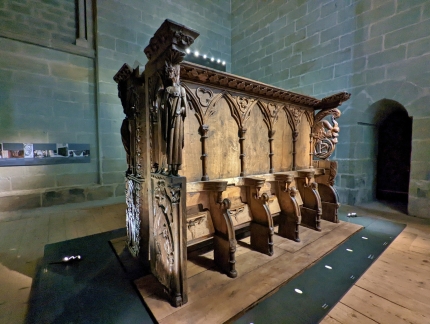 |
Stalls
Position: 46°31.35’N, 6°38.10’E
Carved oak stalls dating from the 13-century were erected in the nave for the church’s consecration (the act of making something sacred) and now are preserved in the belfry.
|
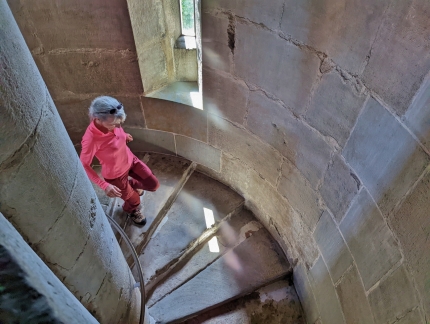 |
Descending
Position: 46°31.35’N, 6°38.10’E
Heading back down the 224 steps from the top of the belfry back to the inside of the cathedral. These steps have seen a lot of wear over the centuries.
|
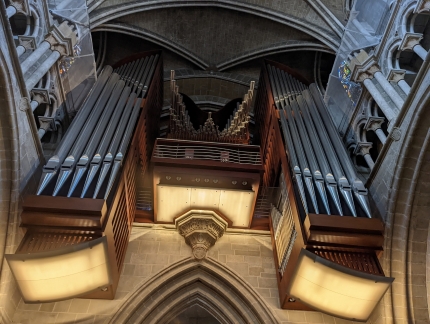 |
Organ Pipes
Position: 46°31.35’N, 6°38.10’E
The 7,369-pipe organ, installed in the Cathedrale du Notre Dame in 2003, is unique in a number of ways. It is the first American-built organ to be installed in a European cathedral, the first to to contain all four of the principal organ styles (classical, French symphony, baroque, German romantique), and the first to have been designed by a designer. Giorgetto Giugiaro, who designs the coachwork (bodies) of many fine Italian cars including some Ferraris and Lamborghinis, designed the body of the organ, at center, to resemble an angel floating on a cloud of light. The organ took 150,000 hours to build at a cost 6 million Swiss francs, and weighs 40 tons.
|
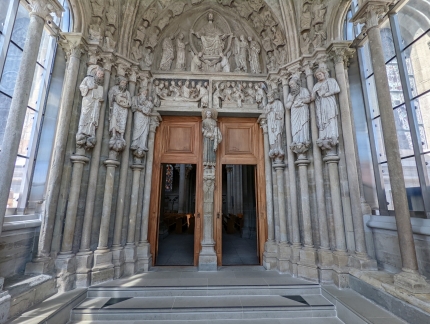 |
Painted Portal
Position: 46°31.37’N, 6°38.09’E
This former entrance to the Cathedrale du Notre Dame in Lausanne is now protected with high-tech glass. The intricately-carved statues date from the 13th century and initially were colorfully painted.
|
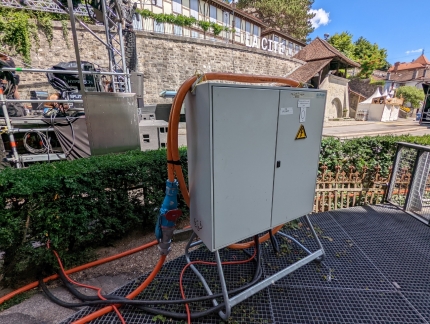 |
Portable Power
Position: 46°31.38’N, 6°38.03’E
A portable power box to supply the high loads needed for the adjacent Festival de la Cite stage.
|
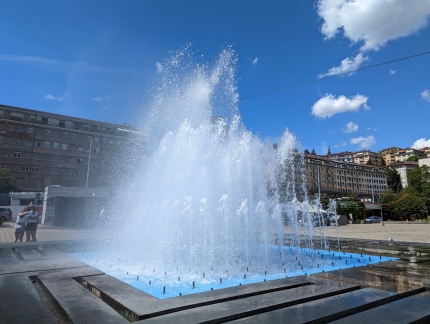 |
Eau-de-Vie
Position: 46°31.38’N, 6°37.99’E
The fountain Eau-de-Vie in Place de la Riponne was completed in 1993.
|
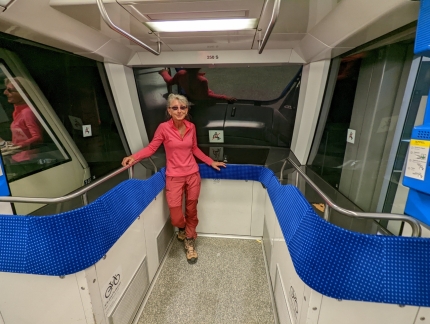 |
Lausanne Metro
Position: 46°31.38’N, 6°37.95’E
At the front of the carriage on the M2 line of the Lausanne Metro to ride back down towards Lake Geneva. The fully-automated rapid-transit line was completed in 2008, replacing a funicular railway that dated from 1877.
|
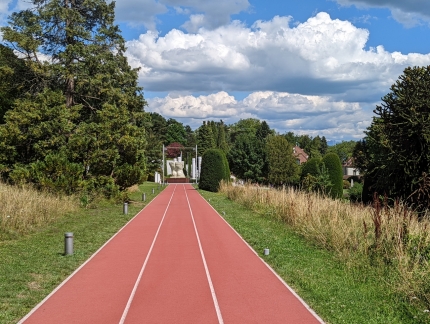 |
Olympic Headquarters
Position: 46°30.52’N, 6°37.93’E
The International Olympic Committee (IOC) has been headquartered in Lausanne since relocating from Paris in 1915, and the Swiss city also is home to the Olympic Museum. This is looking down a 100m athletics track towards the museum entrance.
|
 |
High Jump
Position: 46°30.50’N, 6°38.02’E
Jennifer finds it difficult to imagine leaping over that bar, even with pole assistance.
|
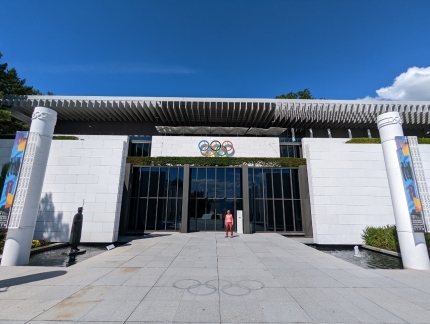 |
Museum Entrance
Position: 46°30.50’N, 6°38.04’E
At the entrance to the Olympic Museum in Lausanne. The museum was founded in 1993 and owns the largest collection of Olympic memorabilia in the world, with over 10,000 items.
|
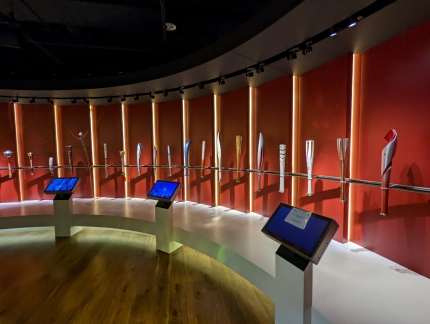 |
Torches
Position: 46°30.52’N, 6°38.05’E
A display of the torches from every edition of the Olympic Games since 1936.
|
 |
Lillehammer
Position: 46°30.52’N, 6°38.07’E
Video of the opening ceremony at the 1994 Winter Olympic games in Lillehamer, Norway. We walked to the top of the ski jump pictured on our road trip from Bergen to Sweden.
|
 |
Kerri Strug Loetard
Position: 46°30.51’N, 6°38.07’E
The Olympic Museum has a large collection of athlete’s equipment and clothing that we found particularly interesting. This is the leotard worn by US gymnast Kerri Strug in the 1996 Olympic games in Atlanta, who became a national sports hero for her courage. After landing badly on the vault and severely twisting her ankle, Kerri made a second, spectacular vault and secured the gold medal for her team. She collapsed and was taken away by medical staff, and shortly later was famously carried back in by her coach with her leg in plaster.
|
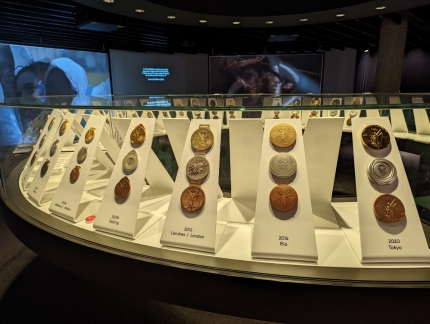 |
Medals
Position: 46°30.52’N, 6°38.04’E
A display of Olympic Games medals from 1896 to the present day.
|
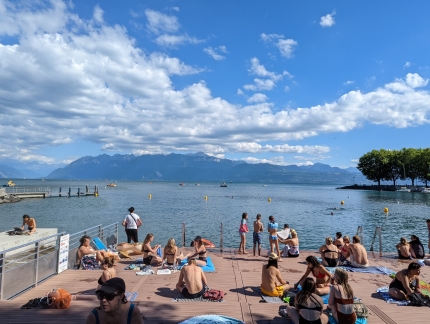 |
Sunbathers
Position: 46°30.41’N, 6°37.75’E
As we walked back towards the train station from the Olympic Museum, we passed groups of sunbathers along the shore of Lake Geneva.
|
 |
Le Chateau d’Ouchy
Position: 46°30.41’N, 6°37.61’E
Le Chateau d’Ouchy hotel was initially a medieval castle dating from the 12th century. Much of it burned down and was in ruins when it was rebuilt in the late 1800s as a hotel.
|
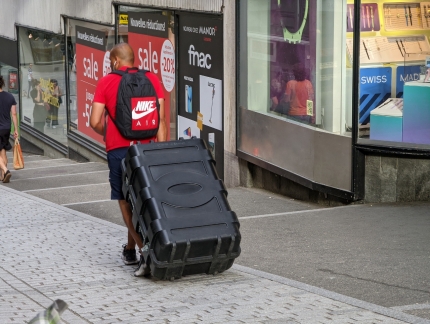 |
Luggage
Position: 46°31.34’N, 6°37.87’E
This suitcase redefines big in the checked luggage department.
|
 |
Dinner
Position: 46°31.34’N, 6°37.88’E
A wonderful meal street-side at Brasserie Saint-Laurent in Lausanne.
|
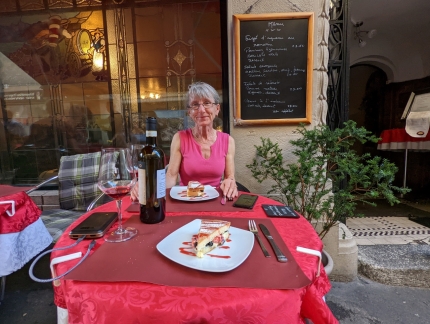 |
Desert
Position: 46°31.35’N, 6°37.87’E
We didn’t order desert, but the couple that run Brasserie Saint-Laurent brought us a complementary piece of cake with fresh berries to finish our meal. It was delicious.
|
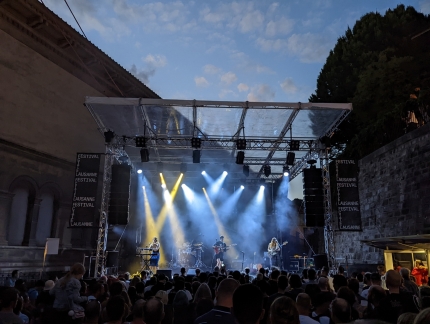 |
Porridge Radio
Position: 46°31.37’N, 6°38.04’E
Before returning back to our hotel, we spent some time watching the British band Porridge Radio perform at the Lausanne Festival de la Cite. It was a wonderful setting for a festival and we enjoyed the bit we were able to experience.
|
 |
Click the travel log icon on the left to see these locations on a map. And a map of our most recent log entries always is available at mvdirona.com/maps. |

If your comment doesn't show up right away, send us email and we'll dredge it out of the spam filter.